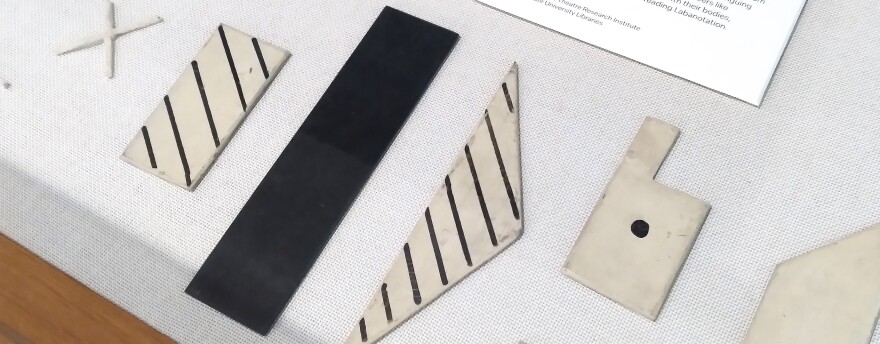At the end of a long night of clubbing, you leave your moves on the dance floor. But if you wanted to write those moves down for next time, how would you do it?
Choreo/Graphics: Diagramming Dance and Movement, an exhibition chronicling the long history of attempts to preserve three-dimensional movements unfolding in four-dimensional time into two-dimensional space, is on view now through Feb. 1, 2026, in Ohio State University’s Thompson Library Gallery.
“It really came from a lot of inspiration that I’ve taken from people’s efforts through time to take down dance—this moving phenomenon that you can’t really capture—and put it on paper or in some other written form,” said exhibition curator Mara Frazier, curator of dance in the Lawrence and Lee Theatre Research Institute, Thompson Library Special Collections, of Ohio State University Libraries.
The exhibition includes historical documents in dance notation systems devised centuries ago. But most of the items on display document the groundswell of interest during the twentieth century in creating ways to write down dances and the technologies invented for that purpose, many of which were developed at Ohio State.
Before the twentieth century, a prevalent view held that dance was more a social-cultural activity than an art form. But with the advent of modernism, dance began to be seen as a serious art worthy of being preserved.

“Many choreographers of the twentieth century thought, if we can write this down, then we can have a literature of dance. We can pass that (down) and store it in libraries and transmit it from person to person. So, as modern dance and neoclassical ballet arose, so did dance notation,” Frazier said.
The rise of dance notation in the twentieth century is intertwined with Ohio State University’s becoming an international center for dance notation. This rich and unique history is another engine behind the Choreo/Graphics exhibition.
Among many forms of dance notation to emerge during the twentieth century was Labanotation, devised by the Austro-Hungarian dancer and choreographer Rudolf von Laban. Labanotation has been promulgated by the New York City-based Dance Notation Bureau, a major center for preserving dance, since the bureau’s founding in 1940 and is still widely used for recording dances.

Ohio State’s Department of Dance has been a major center for the study and creation of dance notation since its founding in 1968. The department’s first chair, Helen Alkire, envisioned the study of dance as a scholarly activity, complete with a repertory of dances available for study in written form.
“She had a vision that a system of writing dance would really legitimize dance in this research university environment, that the manuscripts would be housed in the Ohio State University Libraries in the Rare Books and Manuscripts at the time and that she would build a curriculum that incorporated dance notation and learning the dance repertoire as part of that,” Frazier said.

Dancer and choreographer Lucy Venable, who directed the Dance Notation Bureau from 1961 to 1967, joined the faculty of OSU’s Department of Dance in 1968, bringing with her the DNB’s collection of dance scores. That same year, Venable also founded the Dance Notation Bureau Extension Center for Education and Research at Ohio State University.
Occupying a major position in the international dance world, the extension center promotes recording dances in notation, the development of dance notation and the preservation of dance-related archival materials for use and study by the worldwide dance community.
“It’s a global center,” Frazier said. “Not only did that way of thinking about analyzing movement and recording dance and transmitting and preserving dance infuse the department throughout those decades after the department was created, but it also allowed the department to build out areas like dance and technology and to be a place where really exciting projects in data visualization of movement and motion capture and more recent technologies are part of the discourse.”
Choreo/graphics offers snapshots of the development of dance notation technologies. Among other items on display is a rare instance of an IBM Selectric typewriter with a typeball designed to type Labanotation symbols. That typeball technology had its start with Venable, who collaborated with IBM to develop it while still at the Dance Notation Bureau and continued working on the project more remotely after joining the Ohio State faculty.
Viewers can also see examples of digital dance notation created in the app KineScribe, developed by OSU Associate Professor of Dance Hannah Kosstrin and Chris Summers, media manager and instructional technologist in OSU’s Department of Dance. LabanLens, an application for the Microsoft HoloLens developed at Ohio State by a team led by Kosstrin, allows for augmented reality dance notation. And a motion capture suit offers a high-tech glimpse of how dance notation can come about.
“The dream is to automatically produce notation from motion capture,” Frazier said.

A multimedia dimension of the exhibition allows viewers to watch videos of major dance productions currently being notated or brought to life from the score. And a selection of oral histories record some of the dance world’s most noted contributors talking about dance, dance notation and why they matter.
In the end, dance notation matters because movement is everywhere. In an age when everything can be recorded but even video doesn’t always preserve choreographers’ true intentions, saving the fleeting moments of dance in a precise written language is nothing short of holding onto time and space, even as we move through them.
“The exhibit is really a statement of the importance of how we move through the world and how we record things,” Frazier said. “So, even though dance notation may seem like a strange and obscure topic, it’s kind of everywhere. And I think the exhibit is an exciting way to share that.”
Choreo/Graphics: Diagramming Dance and Movement is on view through Feb. 1, 2026 at the Ohio State University’s Thompson Library Gallery.





